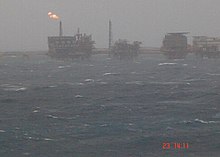Cantarell Field
| Cantarell | |
|---|---|

Cantarell offshore rigs, November 2007
|
|
| Country | Mexico |
| Region | North America |
| Offshore/onshore | Offshore |
| Operator | Pemex |
| Field history | |
| Discovery | 1976 |
| Start of production | 1981 |
| Peak of production | 2004 |
| Production | |
| Current production of oil | 256,000 barrels per day (~1.28×107 t/a) |
| Producing formations | Jurassic |
Cantarell Field or Cantarell Complex is an aging supergiant oil field in Mexico. It was discovered in 1976 after oil stains were noticed by a fisherman, Rudesindo Cantarell Jimenez, in 1961. It was placed on nitrogen injection in 2000, and production peaked at 2.1 million barrels per day (330,000 m3/d) in 2003. In terms of cumulative production to date, it is by far the largest oil field in Mexico, and one of the largest in the world. However, production has declined since 2003, falling to 408,000 barrels per day (64,900 m3/d) in April 2012, making it Mexico's second most productive oil field after Ku-Maloob-Zaap.
Cantarell is located 80 kilometres (50 mi) offshore in the Bay of Campeche. This complex comprises four major fields: Akal (by far the largest), Nohoch, Chac and Kutz. The reservoirs are formed from carbonate breccia of Late Cretaceous age, the rubble from the asteroid impact that created the Chicxulub Crater. The recently discovered Sihil field (1-15,000 million barrels) contains light oil in Jurassic strata below the other reservoirs and is generally referred to as a separate field, although its development will obviously benefit from the infrastructure already in place above it. Cantarell's oil production peaked in 2004 and has declined in subsequent years, with further decline expected in the future.
The Chicxulub impactor produced the Chicxulub crater and subsequent carbonate-debris breccia, which became the oil reservoir for the fields around Villahermosa and the Bay of Campeche where the Cantarell Complex is located. The porosity is 8%-12% in the reservoir at a depth of about 1500 m, which grades from being coarse-grained to fine-grained, called Unit 1 and 2 respectively, and overlain by a seal of shaly ejecta-rich layer called Unit 3.
Following impact, the carbonate platform collapsed, depositing the coarse breccias, which were then overlain mixed and overlain by finer breccias from the consequent tsunamis.Folding occurred in the early Miocene to Pliocene and the compression forced up Cretaceous and Upper Jurassic blocks forming the Structural trap in which hydrocarbons migrated in the Miocene. There are four blocks in the Cantarell Complex, Akal, Nohoch, Chac and Kutz with the Akal block underlain by a fifth block, Sihil, where oil was discovered in 1998.
...
Wikipedia
